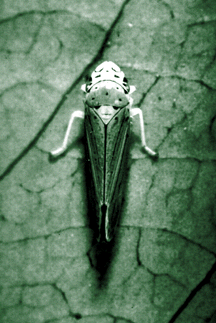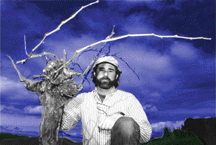Vineyard Vermin: The blue-green sharpshooter acts as a vector for Pierce's disease, a bacterial infection which is turning mountain grapevines into dead stalks.Local grape-growers get caught in sharpshooter's attack
By Christopher Weir
A disease that ravaged Southern California's vineyards in the late 1800s is back and threatens to destroy forever the Santa Cruz Mountains wine industry. Reducing vineyards to wastelands of sickly, skeletal stalks, a precocious little invader known as the blue-green sharpshooter is spreading a vicious bacterial affliction that renders the vines' immune systems impotent. Once infected with Pierce's Disease, vintners frequently choose never to replant again.
"Our vineyard is completely gone," says wine grower Jane McHenry of her McHenry Vineyard in Bonny Doon. "It's wiped out."
As the sharpshooter continues to haunt local vineyards, dismal reports echo throughout the mountains. At the 28-acre site of nearby Bonny Doon Vineyard, the destruction has been complete and permanent.
"The property is for sale," says vineyard manager Steve Tylicki. "There was no evidence that we could successfully replant."
As the blue-green sharpshooter and Pierce's disease unleash more viticultural chaos in the Santa Cruz Mountains, the potential impact could be devastating. It is, after all, a region whose solid reputation is maintained by a mere 700 acres of vines. In a worst-case scenario, many more vineyards would be wiped out, causing financial ruin, reducing local wine production and perhaps inhibiting future wine-growing efforts for the entire region.
The Santa Cruz Mountain landscape isn't one of corporate farmers or winemakers in V-neck sweaters with pearl-white hands, but of families and hard-working dreamers who have invested their pride into small, low-yield vineyards for the sake of distinctive wines.
The coastal range represents a regional crossroads that includes portions of Santa Clara, San Mateo and Santa Cruz counties. The flatlands and valley floors of these counties were first enlisted for wine production by the missionaries. By the mid-1800s, scores of European immigrants were importing their wine-making inspirations to these areas and planting vineyards alongside other crops. The fertile, sizzling Santa Clara Valley and, later, the hardier Santa Cruz Mountains proved to be the locations of choice for early commercially oriented wine growers.
While the Santa Clara Valley gradually lost its agricultural identity under the onslaught of development, the Santa Cruz Mountains have retained a strong viticultural identity, a testament to the sturdy souls who first recognized the region's potential. With, in the words of one historian, "an almost fanatic, idealistic devotion" to the craft of wine making, the forefathers of the Santa Cruz Mountains established a tradition that lingers today in the vineyards and cellars above Saratoga, Cupertino, Los Gatos, Scotts Valley and Bonny Doon. The region remains the heart of local wine-growing renown and is home to several industry leaders. Yet while more and more local vintners are branding themselves into the psyche of California wine, two little pillagers threaten to unravel the foundations of their success.
An assassinative duo when it comes to vineyards, blue-green sharpshooters and Pierce's disease inspire worldwide fear and boast a century-old rap sheet in California. First noted in Anaheim in 1884, Pierce's disease soon raged through Southern California vineyards, wiping out thousands of acres and, to this day, rendering them unfit for viticulture. It continues as the basis for quarantine restrictions placed on the movement of vine cuttings to Europe and other areas where the disease hasn't established a foothold.
In a cruel twist of irony, the same attributes that define the Santa Cruz Mountains are those that could be its undoing if Pierce's disease runs rampant. With hot summer days and cool, marine-influenced nights, many mountain vineyards possess a climate that is ideal for chardonnay and pinot noir, the most widely planted varietals in the region. And these early-ripening, Burgundian varietals are especially susceptible to Pierce's disease.
Vineyard infection is a fairly simple process: the sharpshooter picks up the bacterium from host plants, then introduces it into another plant's xylem--the fluid-conducting system--during its feeding ritual. Generally, dead spots develop and spread across the infected vine leaves, ultimately causing them to fall, with just the petiole, or leafstalk, remaining. As the infection spreads, vine canes (shoots) become stunted, and the grape clusters discolor and wither. Within a few years the vine, literally choked of its lifeblood by internal immune-system combat, dies.
"You see this rapid collapse," says Larry Bettiga, the local University of California viticulture farm advisor. Because sharpshooters and Pierce's disease are nothing new to the forest, there's something else at work behind the sudden vineyard outbreaks. "The cyclical nature of the severity has never been explained. It's part of the great mystery."
The cyclical pattern, however, applies more to North Coast vineyards. Along the Napa River, the situation has been called "horrendous," while in Sonoma County the disease has merely turned itself up a notch. But in the Santa Cruz Mountains, the assault is without precedent. Blue-green sharpshooters reproduce not only in the riparian vegetation of streambeds, but also on the blackberry and elderberry plants that flourish in the sunnier areas of the mountains' lush redwood forests, and serve as hosts for Pierce's disease, an interaction that renders the sharpshooter a vector for the bacteria.
Some have blamed drought for chasing sharpshooters out of the parched woodwork, while a more traditional perspective holds that late, heavy rainfalls are conducive to sharpshooter population explosions that jumpstart outbreaks.
Strangely, both could be true, depending on other regional characteristics. Science has yet, however, to fully grasp this complex matrix of hosts, climates and transmissions. In 1993, Bettiga and Alexander "Sandy" Purcell, a professor of entomology at UC- Berkeley, toured infected vineyards in the Santa Cruz Mountains and conducted a variety of tests to monitor the behavior of the local blue-green sharpshooter populations. Hundreds of yards of yellow sticky tape were stretched around the vineyards to catch sharpshooters and determine their travel patterns, and the vineyards themselves were placed under ongoing scrutiny. What they found was that the vine-attacking sharpshooters' favored habitats and movements in the Santa Cruz Mountains are different than those in hot spots on the North Coast, where they breed in the peripheral riparian habitats. In the Santa Cruz Mountains, however, they breed primarily on the vines.
What occurs, then, is a vicious cycle, whereby the disease is not only spread from peripheral vegetation to vines, but also by young sharpshooters that, after feeding on diseased leaves, spend the winter in the forest, only to return to the vineyard to reproduce the following spring.
"The problem with the Santa Cruz Mountains area is that it's an edge-effect disease," says Purcell, explaining that sharpshooters restrict most of their vineyard activity in proximity to their surrounding habitats. "Small vineyards are all edge." So, unlike the North Coast, where many vineyards sprawl for hundreds of acres, most of the vines in the Santa Cruz Mountains are at risk because they reside in small blocks.
"When the situation gets rolling, you have a major problem," Purcell says.
Greg Stokes watched powerlessly as Pierce's disease decimated row after row of prized vines at David Bruce Winery, a 25-acre estate vineyard located between Los Gatos and Ben Lomond ,which for decades yielded some of the region's most distinctive and critically acclaimed wines.
"It just mowed through everything," the vineyard manager says of the Pierce's disease infestation. "It was amazing."
Fine Vine: Pierce's disease has mowed through vineyards in the Santa Cruz Mountains, including the critically acclaimed David Bruce Winery, which recently replanted in hopes of survival.Planted in the early 1960s, David Bruce's vineyard produced what many considered some of the area's finest chardonnays and pinot noirs. But in 1991, sharpshooters started to stoke the disease into a limited but undiagnosed fury. Then all hell broke loose.
On one five-acre block, Stokes recalls, they picked a normal crop in 1993. And just one year later, only five vines of the entire block remained healthy. In that same year, the estate yield fell from 36 tons to two.
"We lost the whole vineyard to Pierce's disease," he says. As the winery awaits a full crop from its recently replanted vineyard, it's relying on grapes from a local, independently owned seven-acre vineyard that it manages under contract. Meanwhile, the loss of production coupled with the cost of replanting have put the winery's tenacity to the test.
"Economically, it's kind of tough," Stokes says, his tone that of classic understatement.
Bonny Doon Vineyard's Tylicki takes a more apocalyptic view.
"It's kind of like closing the barn door after the horses are out," he comments. "There's a certain amount of denial to Pierce's disease because essentially there's nothing you can do about it. After employing every available option, he says of the vineyard, "We just struck out."
With that, the area lost a unique vineyard, one planted to the more esoteric Rhone varietals of Roussanne, Marsanne, Syrah and Viognier. Fortunately for the winery, the vineyard's yield comprised only a fraction of its total production.
The McHenry's over at McHenry Vineyard haven't fared much better. "The last of the vines were pulled up at Christmas time," says Dean McHenry, who is also chancellor emeritus at UC-Santa Cruz. The McHenry's four-acre vineyard, planted in 1973, was the source for the family winery's 400-case production of chardonnay and pinot noir. "We were perhaps the epicenter of the attack."
He shakes his head. "Ultimately, the vines were just dead stalks."
The outbreak has made other vintners wary. As if to demonstrate its nefarious mobility, Pierce's disease is starting to flash around Kathryn Kennedy Winery, where the eight-acre estate cabernet sauvignon vineyard in Saratoga is surrounded not by sharpshooter-ridden host plants, but by residential development.
"It has some very distinct symptoms of Pierce's disease," says Kennedy wine grower Marty Mathis of the vineyard. "That's very worrisome to me."
Others who have been spared such symptoms are glancing nervously over their shoulders.
"Sometimes you don't want to look for those things," says Ron Mosley, vineyard manager at Cinnabar Vineyards and Winery. "But to be a good rancher, you need to monitor it," he adds. Although Pierce's disease hasn't hit Cinnabar's 30-acre estate vineyard, its fearsome reputation has Mosley on alert and grasping for the words to express his situation. It all comes down to one thing: "You have to do the best you can."
In the ecological labyrinth of the Santa Cruz Mountains, there exists no easy battle plan against the blue-green sharpshooter. Evading Pierce's disease is almost as tricky and aggravating as dealing with it, and insecticides are not the panacea of choice.
"You can't spray for everything," Mosley says. "You have to coexist with some of these problems...and be ecologically minded."
The region has traditionally enjoyed an ecological balance that keeps vineyard pests in check by entertaining a number of predatory pests and parasites that feed on them. Insecticides are not selective, so while they can eliminate a focal problem, they also eliminate predators. That, in turn, can set the stage for exponential viticultural headaches and a reliance on chemicals. And that's something the wine growers want to avoid.
Sometimes, however, spraying is the only option when faced with sudden infestations. Vineyard application of dimethoate insecticide, says Purcell, can reduce the sharpshooters' "threat rating" by not only reducing their population, but also the percentage of those infected with the disease. Purcell, who is recognized as the leading researcher on the subject, says a more proactive approach is surgical perimeter clearance of host plants that catalyze the vectoring process.
But overall, says Tylicki, "It's not realistic to talk about eliminating the sharpshooter" without evoking the helicopter armadas of the infamous Mediterranean fruit fly wars. And as for the disease itself, he says, no proven antibiotic mitigation has surfaced. And because it's illegal to use antibiotics on vineyards in California, "The point is moot."
Jim Beauregard, a veteran Santa Cruz Mountains vineyard owner, has seen significant portions of his chardonnay vines succumb to the disease in recent years. In the absence of scientific conclusions, he is resorting to the farmer's best friends: intuition and innovation. He's ripping the soil to increase air and nutrient circulation to the roots, and is also severely pruning the vines. Ideally, this rids the vine of its infected and dead wood, and concentrates its energy toward fresh, healthy growth. He says he's already had some success with this approach.
"My vineyard has become an experiment," he says with a mirthless chuckle.
Ultimately, the branding by Pierce's disease could be indelible. As it reshapes the region by eliminating vineyards altogether or restructuring their varietal content, the Santa Cruz Mountains are losing acres of vines and varietals that have crystallized their legacy.
"It's hard to know what will happen in the future," says UC's Bettiga. "It's a very tough situation." The hardest-hit area, Bonny Doon, could become a viticultural ghost town.
But the misfortunes of Pierce's disease may, after all, yield some hidden blessings. At David Bruce Winery they've chosen some different vine clones and trellising systems that will enhance the quality of their fruit, Stokes says. They've also added syrah to their lineup, which is in step with sharpening consumer interest in Rhone varietals.
"We're going to make better wine," he says.
And while his optimism remains untested, it resonates in the fighting words of Jim Beauregard: "I don't think we're doomed."
Because in an industry hallmarked by innovative New World defiance, doom is rarely a safe bet.
From the Feb. 28-Mar.6, 1996 issue of Metro
This page was designed and created by the Boulevards team.
Copyright © 1996 Metro Publishing and Virtual Valley, Inc.


